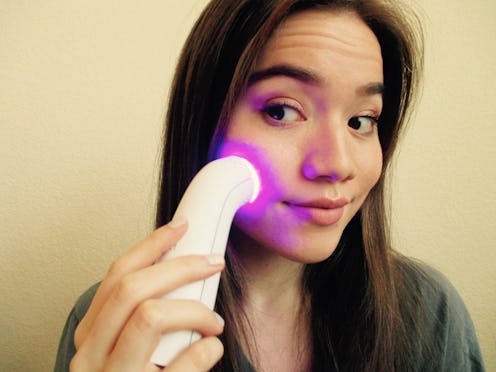Fashion
This Is How Acne Light Treatments Actually Work

If you're someone who struggles with acne, you probably have a pretty good idea of what kind of treatments are out there to help. But if you've ever seen those little blue-light devices and haven't tried one yet, you might be wondering how acne light treatments work. After all, when you're used to just dabbing a cream on your breakouts, shining a blue spotlight on them instead might seem a little strange. So to find out exactly how these hand-held devices work and how long it might take to see results, I emailed with Dr. Marnie Nussbaum, M.D., New York City dermatologist.
According to Dr. Nussbaum, these light treatments work by actually penetrating the skin's pores to destroy acne-causing bacteria. In so doing, it prevents this bacteria from feeding off oil glands and causing redness and inflammation, so that acne is healed from within. Compared to traditional, topical treatments that combat inflammation and bacteria on the surface of the skin but may not be able to penetrate without causing irritation, light treatments are better able to target the source of acne flare-ups, explains Dr. Nussbaum. And while you can visit your dermatologist for an in-office, blue-light treatment, you can reap the same benefits with an at-home device.
Tria Positively Clear 3-Step Acne Skincare Solution, $169, Amazon
With an at-home device like the one pictured here, Dr. Nussbaum says that one can start to see a difference in just two weeks, and an improvement in breakouts in eight weeks when it is used on the affected area for five minutes every day. But while any skin type can benefit from a blue-light treatment, Dr. Nussbaum warns that it should only be used on certain types of breakouts.
Blue-light treatments for acne are "best used for mild to moderate acne without open sores or large cysts causing scarring," says Dr. Nussbaum. And what's more is that they can also be used on the body in addition to the face. However, she stresses that other skin conditions such as rosacea or infections should not be treated with a blue light.
If you're interested in trying a light treatment for yourself, Dr. Nussbaum reminds to "Always look for an FDA-cleared light device which has been tested and approved for proper use, and always use the device as the instructions provide." And while there are different types of light devices to target various conditions and concerns, blue lights are specifically for eliminating acne-causing bacteria and clearing up breakouts.
Because shining a spotlight on your acne can actually help make it go away.
Images: Miki Hayes (1); Courtesy of Brand